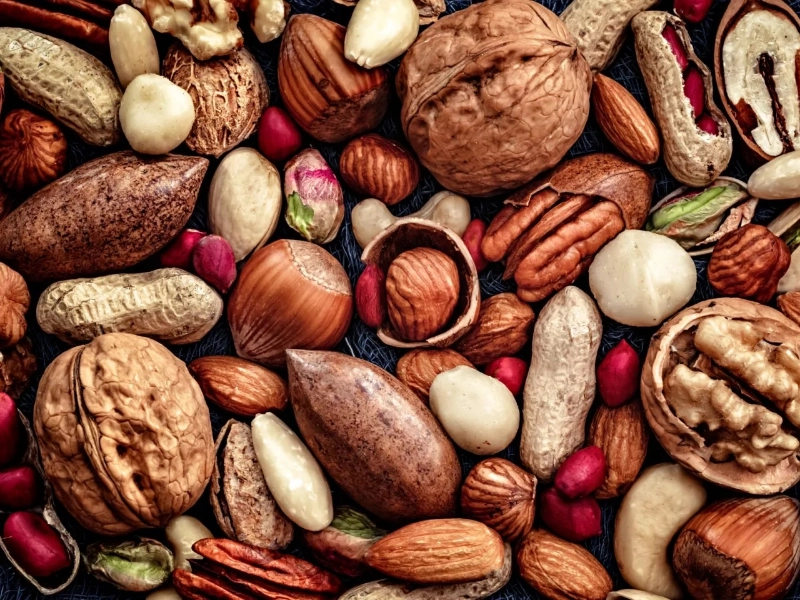The Potential of Nuts in Your Diet to Fight Cancer
Nuts offer a variety of nutrients that prevent cancer, including tree nuts and peanuts, which are linked in composition. They are also a rich source of healthy fats and protein. Increased nut consumption has been linked to lower cancer risk and mortality, according to several studies. This is mostly because of how nuts affect angiogenesis, inflammation, and the proliferation of cancer cells.
Ingredients

Fibre
 Antioxidants and phytochemicals that fight cancer can be found in high-fibre foods like berries, whole grains, and beans. These nutrients can reduce inflammation, stop cell damage, and stop the growth of tumours. They also prolong your feeling of fullness, which aids with weight management.
A diet high in fruits, vegetables, whole grains, and nuts may reduce the risk of cancer, according to studies. For instance, walnut eating was observed to lower the size and incidence of adenomatous polyps in patients with familial adenomatous polyposis.
Whole grains like quinoa, brown rice, and oats are high in fibre, which helps to maintain digestive health and may reduce the risk of colorectal cancer. Apples, figs, raisins, apricots, prunes, and figs are some more foods high in fibre. To yoghurt, muesli, and porridge, add chia seeds, ground flax, or walnuts. You may also sprinkle them over salads.
Antioxidants and phytochemicals that fight cancer can be found in high-fibre foods like berries, whole grains, and beans. These nutrients can reduce inflammation, stop cell damage, and stop the growth of tumours. They also prolong your feeling of fullness, which aids with weight management.
A diet high in fruits, vegetables, whole grains, and nuts may reduce the risk of cancer, according to studies. For instance, walnut eating was observed to lower the size and incidence of adenomatous polyps in patients with familial adenomatous polyposis.
Whole grains like quinoa, brown rice, and oats are high in fibre, which helps to maintain digestive health and may reduce the risk of colorectal cancer. Apples, figs, raisins, apricots, prunes, and figs are some more foods high in fibre. To yoghurt, muesli, and porridge, add chia seeds, ground flax, or walnuts. You may also sprinkle them over salads.
Complete Protein
 Protein from nuts contains amino acids, which can aid in reducing inflammation and accelerating healing. They also include phytosterols and tocopherols, two types of antioxidants.
People who eat nuts have been shown to have a lower risk of cancer in several prospective studies. For instance, women who frequently consumed nuts had a decreased incidence of breast cancer in the Nurses' Health Study.
Scientists believe that nuts' potential chemopreventive properties stem from their impact on the gut microbiota. Bacteria in the colon transform the ellagtannins found in walnuts and pecans into urolithins, which have been demonstrated to boost antioxidant enzymes and induce apoptosis.
Nuts may help prevent weight gain and obesity, which raise the risk of various cancers, according to additional studies. However, it is challenging to identify long-term patterns because the majority of nut-eating research only examines exposure and habits at one particular point in time.
Protein from nuts contains amino acids, which can aid in reducing inflammation and accelerating healing. They also include phytosterols and tocopherols, two types of antioxidants.
People who eat nuts have been shown to have a lower risk of cancer in several prospective studies. For instance, women who frequently consumed nuts had a decreased incidence of breast cancer in the Nurses' Health Study.
Scientists believe that nuts' potential chemopreventive properties stem from their impact on the gut microbiota. Bacteria in the colon transform the ellagtannins found in walnuts and pecans into urolithins, which have been demonstrated to boost antioxidant enzymes and induce apoptosis.
Nuts may help prevent weight gain and obesity, which raise the risk of various cancers, according to additional studies. However, it is challenging to identify long-term patterns because the majority of nut-eating research only examines exposure and habits at one particular point in time.
Fatty Acids Omega-3
 Consuming a diet rich in omega-3 fatty acids, also known as polyunsaturated fats (PUFAs) due to the many double bonds in their carbon chains, can help prevent cancer. [3] The phospholipids that make up cell membrane structures include omega-3 fatty acids, which are also needed to create the signalling molecules known as eicosanoids.
In addition, the prevention of diabetes, heart health, brain function, and blood pressure regulation all depend on these fatty acids. Because they are necessary fats, the body cannot produce them and has to get them from food or supplements.
Consumption or blood levels of EPA and DHA have been linked to a decreased risk of prostate, endometrial, breast, and colorectal cancers, according to a number of prospective and case-control studies. [6]
Consuming a diet rich in omega-3 fatty acids, also known as polyunsaturated fats (PUFAs) due to the many double bonds in their carbon chains, can help prevent cancer. [3] The phospholipids that make up cell membrane structures include omega-3 fatty acids, which are also needed to create the signalling molecules known as eicosanoids.
In addition, the prevention of diabetes, heart health, brain function, and blood pressure regulation all depend on these fatty acids. Because they are necessary fats, the body cannot produce them and has to get them from food or supplements.
Consumption or blood levels of EPA and DHA have been linked to a decreased risk of prostate, endometrial, breast, and colorectal cancers, according to a number of prospective and case-control studies. [6]
Antioxidants
 One of the hottest subjects in health news these days is antioxidants. From the newest health magazine to the online headlines, and even at your physician's office, you hear about them all the time.
To put it briefly, free radicals are unstable chemicals that antioxidants neutralise. Although the body naturally produces free radicals during its metabolic processes, outside influences such as pollution, UV light, and cigarette smoke can also produce them. Oxidative stress can cause chronic illnesses like diabetes and cancer when its levels rise.
Antioxidants come in a variety of forms, such as vitamins C and E, carotenoids, flavonoids, and the minerals isoflavones, quercetin, and resveratrol. Additionally, foods like dark chocolate, tomatoes, and red peppers contain them. With the exception of tocotrienols and the lipid-soluble substances a- and gamma-tocopherol, the majority are soluble in water.
One of the hottest subjects in health news these days is antioxidants. From the newest health magazine to the online headlines, and even at your physician's office, you hear about them all the time.
To put it briefly, free radicals are unstable chemicals that antioxidants neutralise. Although the body naturally produces free radicals during its metabolic processes, outside influences such as pollution, UV light, and cigarette smoke can also produce them. Oxidative stress can cause chronic illnesses like diabetes and cancer when its levels rise.
Antioxidants come in a variety of forms, such as vitamins C and E, carotenoids, flavonoids, and the minerals isoflavones, quercetin, and resveratrol. Additionally, foods like dark chocolate, tomatoes, and red peppers contain them. With the exception of tocotrienols and the lipid-soluble substances a- and gamma-tocopherol, the majority are soluble in water.










